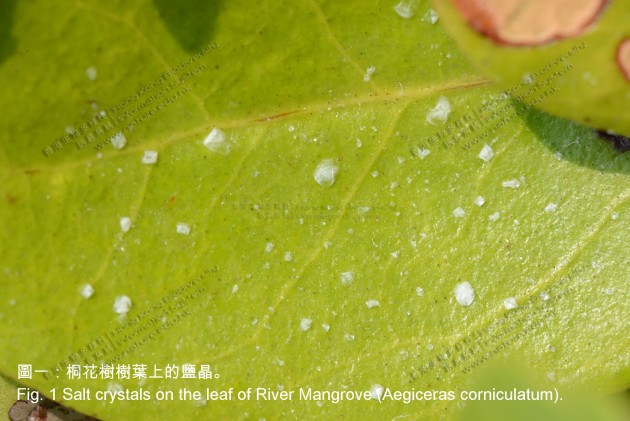沿岸植物的適應 Coastal Plant Adaptations
29-07-2015
在沿岸地帶,不難發現植物的縱影,例如各種紅樹和沙灘植物。可是,要在這些環境生長,植物需要面對幾個難題。第一,泥土、水中鹽分太高;第二,泥土太濕,氧氣太少;第三,不易從泥中獲取淡水;第四,種子難以發芽;第五,風力太強。面對如此嚴苛的環境,沿岸植物竟展示出不同「對策」。
1. 降低鹽分
生活在潮間帶的植物,需要面對高而多變的鹽度:漲潮時泥土被海水覆蓋,退潮時海水被陽光蒸發,鹽度更高。 潮間帶的植物主要有兩種保持自身鹽度穩定的方法:避免吸收過多鹽分,以及排出多餘的鹽分。
某些紅樹的根部有特別的過濾系統,或者被一層蠟質包裹,可以過濾大部分的鹽。
更多的紅樹,例如桐花樹(Aegiceras corniculatum),則在葉底長有鹽腺,多餘的鹽分會從鹽腺排出,故葉面上常常會有白色的鹽晶(圖一)。
另外一些紅樹,例如海漆(Excoecaria agallocha)(圖二)、木欖(Bruguiera gymnorrhiza) 則會把鹽分儲存在老葉裡,待樹葉枯萎脫落時把鹽帶走。
2. 獲取氧氣
潮漲時,泥土中的縫隙都會充滿海水,以致泥土長期缺氧,泥灘上的植物不能從泥土獲得足夠氧分。
要解決氧氣不足的問題,不少紅樹都有氣根幫助呼吸。氣根表面佈滿皮孔,用來交換氣體,根內也有通氣組織,由中空的細胞組成,方便鎖住及運送氧氣。氣根可以分成不同種類,包括出水通氣根、膝狀根、支柱根等。
出水通氣根由植物泥下的纜狀根延伸而成,向上伸出泥土表面,可以達30厘米高,常見於白骨壤(Avicennia marina )(圖三、四)。膝狀根與出水通氣根原理相似,只是形狀不同,木欖和秋茄(Kandelia obovata)都有膝根。
支柱根由主莖向下生長至泥土中,主要用來支撐植物,同時亦幫助交換氣體。
3. 保持水分
淡水對於沿岸植物來說可是得來不易,因此植物需要減少水分喪失,它們的葉都有特別的適應方法。
不少紅樹的葉面上都有一層不透水的厚蠟質皮層和表皮,減低水分從葉片蒸騰的速度(圖五)。
南方鹼蓮(Suaeda australis)葉片小而厚實(圖六),可以儲存更多水分,又能減少水分蒸發面積。
一些紅樹的葉底顏色比葉面淺(圖七),可以更有效反射陽光,使葉底溫度較低,減慢水分蒸發。有些更有一層細毛,形成鎖水層。
此外,有些植物葉底的氣孔向內下陷,形成袋狀開口,減低水分蒸發。其他減少水分流失的方法還有把葉轉離陽光等。
4. 繁衍後代
潮間帶泥土狀況不穩定,為了提高種子的生存機會,不少紅樹都有胎萌現象:果實還未離開樹,裡面的種子已經發芽生長(圖八),成熟時幼苗才與果實一起脫落。若幼苗遇到適合紮根的地點,便能快速生長,省卻發芽的步驟。
紅樹果實大都有浮力,如秋茄(水筆仔),它的果實能夠垂直在水中飄浮,遇到適合的泥土便能馬上插入生長。
5. 抵禦強風
沿岸地帶,尤其在沙灘,通常風勢都會較強。植物要避免連根吹起之餘,也要防止自己被泥沙覆蓋。
為了減少與強風接觸,沙灘上的植物大多匍匐而生,甚至只把葉的一部分露出地面,而地底根部卻非常深而廣,以抓緊泥沙,同時尋找水源。 匐枝栓果菊(Launaea sarmentosa)便是一個好例子(圖十)。
厚藤(海灘牽牛)(Ipomoea pes-caprae)的莖部橫生在地表,並有大量不定根,以避開強風及增加抓地能力(圖十一)。
珊瑚菜(Glehnia littoralis)的葉雖然貼近地面,但花卻離地稍高(圖十二),原因是為了避免海風吹起的沙把花掩埋。
香港沿岸植物在嚴苛的環境下仍能茁壯生長,展現了頑強不屈的生命力,更提供了供不同物種棲息的空間,故我們欣賞之餘,也要學會珍惜愛護這些植物。
It is not difficult to find plants such as mangroves and sandy beach plants in coastal areas. However, to survive in this environment, there are some challenges the plants must face Firstly, a high soil and water salinity. Next, a low oxygen level because of high soil moisture. Then, the difficulty of obtaining fresh water from the soil. Fourthly, the difficulty in developing new plants from seeds. Last but not least, very strong winds. Surprisingly, coastal plants have displayed various measures to counter such a harsh environment.
1. Lowering salinity
Plants living along intertidal zones have to face high but ever-changing salinities. During high tides, the soil will be submerged in seawater, while during low tides, evaporation causes soil salinity to become even higher. To maintain a stable salinity in its own body, intertidal plants have two ways to choose: avoid absorbing too much salt, or expelling excess salt.
Some mangroves have special filtration mechanisms in their roots or have wax-covered roots to avoid most of the salt intake.
Many others, such as the River Mangrove (Aegiceras corniculatum), have salt glands under the leaves to expel excess salt. Often salt crystals can be seen on the leaf surfaces as white patches (Fig. 1).
Some other mangroves, like the Milky Mangrove (Excoecaria agallocha) (Fig. 2) and the Many-Petaled Mangrove (Bruguiera gymnorrhiza), store the salt in their older leaves. When those leaves wither and fall, the salt can be taken away with them.
2. Obtaining oxygen
In times of hide tides, gaps between soil particles will be filled with seawater, causing the soil to maintain a prolonged low oxygen level. Thus, plants cannot obtain enough oxygen just from soil.
To solve this problem, many mangroves have aerial roots to aid in absorbing air. The aerial roots are covered with lenticels for gaseous exchange. Moreover, inside the roots are spongy tissues with a lot of spaces for easier locking and transporting of oxygen. Aerial roots can be classified into different types, such as pneumatophores, ‘knee joint’ roots and propping roots.
Pneumatophores extend from the cable roots beneath the soil. They rise from the soil and can reach a height of 30 cm. They can be commonly seen in the Grey Mangrove (Avicennia marina) (Fig. 3 and 4). ‘Knee joint’ roots have a similar function despite the difference in shape. They are possessed by the Many-Petaled Mangrove and Kandelia obovata.
Propping roots grow from the stem downwards into the soil. Their main function is to support the plant but they help in breathing as well.
3. Keeping moisture
To coastal plants, freshwater is a precious resource. Therefore, they strive to reduce water loss. This is achieved by developing adaptation features on their leaves.
Many mangroves have leaves with a thick waxy cuticle and epidermis, in order to reduce the rate of transpiration of water from the leaf surface (Fig. 5).
Austral Seablite (Suaeda australis) have small but succulent leaves (Fig. 6). This allows storage of plenty of water and at the same time minimizes the area for water evaporation.
The leaves of some mangroves are lighter-coloured on the abaxial (lower) side than on the adaxial (upper) side (Fig. 7). A lighter colour allows better reflection of sunlight, which leads to a lower temperature and hence slower evaporation. Some leaves have a layer of thin hair to prevent water from escaping.
Other than the above mentioned, some plants have sunken stomata on their leaves which form pocket-like openings. This further reduces evaporation rate. Other measures include orienting the leaves away from sunlight.
4. Producing offspring
Owing to the instability of soil conditions in intertidal zones, plants have to think of ways to increase the survival rate of their seeds. One of these ways is vivipary. Even before the fruit detaches from the mother tree, the seed inside has started to germinate (Fig. 8). When mature enough, the seedling leaves the tree with the fruit (called a dropper). This way, once the seedling finds a suitable location it can quickly root itself to the ground and start growing without having to germinate.
Most mangrove droppers have high buoyancy, like those of Kandelia obovata. Its droppers can flow vertically in the water, so once it finds suitable soil, it can easily get caught in the mud and grow.
5. Withstanding strong winds
Winds are often stronger in coastal areas, especially beaches. Plants do not only have to avoid being blown uprooted, but they also have to avoid getting covered by the sand.
In attempt not to face strong winds directly, most plants on sandy beaches grow creeping near the ground. Some even only reveal the leaves above ground, while having a wide and deep root system buried beneath the sand. The root system ensures good anchorage on the sand and look for water at the same time. One good example of such plants is the Beach Launaea (Launaea sarmentosa) (Fig. 10).
Stems of Beach Morning Glory (Ipomoea pes-caprae) lie low on the ground and grow horizontally to stay away from strong winds. A lot of adventitious roots sprout from the stems as well to provide better ground gripping ability (Fig. 11).
Beach Silvertops (Glehnia littoralis) have low-lying leaves but slightly elevated flowers (Fig. 12). This is to prevent the flowers from being buried by the sand blown up by strong winds.
Despite the harsh environment, many plants in Hong Kong can still thrive and display a strong perseverance and liveliness. Besides, they also provide shelter for different wildlife. Therefore, apart from admiring these plants, we should learn to treasure them too.
























